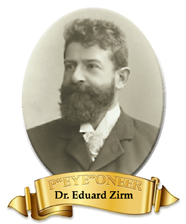
The First of Many P"eye"oneers
This Saturday marks the 108th anniversary of the first successful cornea transplant (or “keratoplasty”), performed by Eduard Zirm, an Austrian ophthalmologist. I am highlighting him here as our first post in a series called P”EYE”ONEERS.
After his medical studies in Vienna, Dr. Zirm accepted a position at a hospital in what was then Olomouc (now in Moravia, Czech Republic). The recipient was Alois Glogar, a day laborer from a small town who had been blinded in both eyes a year earlier while slaking lime. The donor was an 11-year-old boy named Karl Brauer who was brought to the clinic due to an accident that left metal pieces in his eyes. Although complications affected one of Glogar’s eyes, the other remained clear allowing him to return to work.
The operation and healing were difficult at that time because without a microscope it was impossible to suture the cornea. Dr. Zirm successfully used sutures from the outside. Advances at that time in anaesthesia and sterilization have also been credited in Zirm’s success. The milestone ended more than a hundred years of unsuccessful attempts by eye surgeons all around the world.
Since 1961, more than 1,000,000 men, women, and children ranging in age from nine days old to over 100 years-old, have had their sight restored. Of all transplant surgeries done today, including heart, lung and kidney, corneal transplants are the most common and successful (95% success rate).
A corneal transplant may be needed if these conditions exist:
- Corneal failure after other eye surgery, such as cataract surgery
- Keratoconus, a steep curving of the cornea
- Hereditary corneal failure, such as Fuch’s cornea
- Scarring after infections, especially after herpes
- Rejection after first corneal transplant
- Scarring after injury
- Complications from LASIK (lamellar transplants)
If you are interested in being a corneal donor upon your death, please visit THIS LINK to learn more about donating. An estimated 900 new eye banks are necessary to meet the current demand for eye transplant tissue. There are currently 80 eye banks in the US.
Sources: Wikipedia and Eye Bank Association of America
Have a thought about this article? Contact Us and let us know.